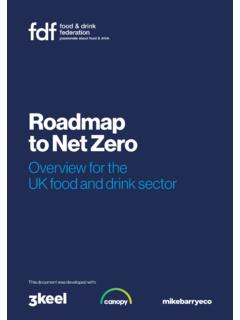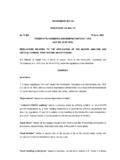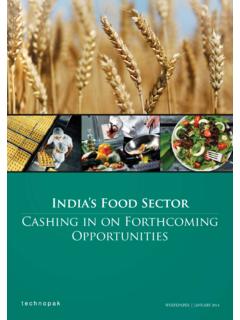Transcription of THE FOOD AND DRINK INDUSTRY
1 THE food . AND DRINK . INDUSTRY . Economic contribution and growth opportunities 2. A SIGNIFICANT 3. ECONOMIC ENGINE. FOREWORD. ACROSS A DIVERSE BASE. The food and DRINK INDUSTRY is the UK's largest The food and DRINK manufacturing sector is the largest manufacturing sector in the UK. manufacturing sector , contributing to In terms of economic contribution, it accounts for 17% of all UK manufacturing GVA ( the economy annually and employing 400,000 billion) 1. It comprises just over 6,800 businesses 2 and employees nearly 400,000 people 3. people. We are a key part of the nation's 110. billion farm to fork' food chain. It is also a growing sector . In terms of economic contribution (measured by GVA), between 1997 and 2015 the sector grew by 27%, making it the fourth fastest growing UK manufacturing sector over this time period and Our INDUSTRY is critical to national security and the significantly outstripping average manufacturing growth of 13%.
2 Between 2010 and 2015, business turnover prosperity of our wider economy. We have a well- grew by 28% with profits growing by 10%. Over this same time period employee numbers grew by 6%. This earned global reputation for provenance, quality and was significantly higher than the 1% growth experienced by the manufacturing sector as a whole, and was at a innovation. level that made the sector more comparable to the economy as a whole (which saw 7% growth) 4. The challenges we face in the next few years are The sector 's diversity is apparent in unparalleled. The market environment in which Figure 1: C. omposition of the food and DRINK three main ways: manufacturing base we operate remains uncertain. We are a resilient he composition of the business base T.
3 And adaptable INDUSTRY - we know there are huge opportunities available to our sector so we can sell 96% of food and DRINK manufacturing 4% % of business which are SMEs businesses are small and medium (between 1-249. more great British food and DRINK . Therefore, it is key Gavin Darby sized enterprises (see Figure 1). This that we identify how best to harness our own growth employees). Chief Executive of Premier Foods is compared to 99% for the UK as a potential and improve productivity. and food and DRINK Federation President whole 5. The mix of both dynamic small % of business With this in mind, FDF commissioned Grant Thornton businesses (146 6 of whom can be which are large to undertake this independent research project identifying both the opportunities available to manufacturers defined as scale ups) as well as large, businesses and the barriers to growth.
4 This was done through the collation of the latest quantitative data and by speaking at length with FDF members to add a qualitative perspective. globally recognised, organisations is a unique feature of the sector . The fact 96% (250 and above employees). that both large and small businesses This research focuses on three core areas: innovation, trade and skills. All are framed against the backdrop Source: Business Population have experienced growth over the last Estimates, 2016 food and of the UK leaving the European Union. The findings highlight the diversity of our INDUSTRY , and in particular, five years underlines the fact that this Beverage manufacturers how risks and opportunities can vary from business to business and across regions. mixed ecosystem is working.
5 The findings also highlight the work we need to do to increase growth and how we can achieve this. The he geographical spread of businesses and employees one of the food and DRINK manufacturing sector 's T. report makes a compelling case for Government to invest in the food and DRINK INDUSTRY , identifying clear defining characteristics is its national presence. Unlike many other manufacturing industries such as actions and areas of support. Our sector has long been a manufacturing success story but it is clear there automotive where a strong regional bias is apparent (see Figure 2) the food and DRINK manufacturing is still much untapped growth potential. sector spans the length and breadth of the United Kingdom in terms of both employment and businesses.
6 In partnership with Government, the food and DRINK INDUSTRY will seize upon these opportunities, maximising As such the sector plays a crucial role at both a local and sub-regional level, as well as the national level as growth and boosting productivity. We believe the food and DRINK INDUSTRY can be an engine for economic noted above. The view from a number of the INDUSTRY leaders consulted as part of this study was that in growth in the UK, while continuing to provide safe, innovative and nutritious food and DRINK to the nation. many local areas the food and DRINK manufacturing sector is a critical part of local communities. 1. Source: ONS Annual Business Survey 6. Source: 2. Source: BEIS Business Population Estimates Number is based on selection of businesses within the 3.
7 Source: ONS Business Register & Employment Survey manufacture of food products' and manufacture of beverages'. 4. Source: ONS Business Register & Employment Survey sub-sectors. 5. Source: BEIS Business Population Estimates 4 5. Productivity is and will continue to be an important their production processes. However, this has not Figure 2: Geographical spread of businesses metric for the sector . Three quarters (76%) of the been without challenge as modern manufacturing , food and DRINK manufacturing Automotive Business Heat Map businesses surveyed as part of this study stated that automation and robotics pose both a significant risk Business Heat Map they actively measure productivity (using a range and opportunity for the sector . Business counts (2016).)
8 30 to 140 of different metrics). Nine in ten (93%) of whom In order to understand how the sector can 25 to 30 stated that they had seen improved productivity build on this strong economic contribution the 20 to 25 over the last three years. This appears to have been study looked in detail at three specific growth 15 to 20 largely driven by capital investment and upskilling opportunities and the associated barriers that 0 to 15 the workforce. The majority of INDUSTRY leaders would need to be addressed. consulted also noted the transformational impact that new machinery and technology has had on Figure 3: Change in labour productivity 2010-2015. Transport equipment 25%. Basic metals & metal products 4%. food , beverage & tobacco 3%. Computer products, electrical equipment 3%.
9 The nature of different industries within the sector Strategy. As a sector , productivity (measured by GVA Rubber, plastics & non metallic minerals -1%. looking within the sector it is instantly apparent per job) improved by 3% between 2010 and 2015. Wood, paper products & printing -1%. how diverse it is with businesses ranging from It is one of only four manufacturing sectors to record Coke & refined petroleum -3%. the processing of fish and meat products to the positive productivity growth during this time period Textiles, wearing, apparel & leather -3%. manufacture of chocolate, bakery goods and ready (Figure 3), although it was significantly lower than the Chemicals & pharmaceuticals -6%. meals. This variety not only offers a breadth of 25% growth experienced in the transport equipment Machinery & equipment -13%.
10 Different opportunities but it also highlights the vital sector . Given this high level of growth has most likely been driven by significant advances in automation -15% -10% -5% 0% 5% 10% 15% 20% 25% 30%. role that the sector plays in creating a link between raw materials and the end shopper and consumer. and robotics there is a clear opportunity for the food and DRINK manufacturing sector to follow suit. If the Evidence of improving productivity, analysis looks at a ten-year time period between with significant potential to realise 2005 and 2015 the food and DRINK manufacturing more sector is one of only two manufacturing sectors (the other being transport equipment) to have shown Improving the UK's productivity remains a key consistent GVA growth over the past decade.














